LASP1 in Cellular Signaling and Gene Expression: More than Just a Cytoskeletal Regulator
Abstract
1. Introduction
1.1. Structural Features of LASP1
1.2. LASP1 Expression
2. LASP1 and Cellular Signaling
2.1. Chemokine Receptor Signaling
2.2. PI3K/AKT/mTOR
2.3. β-Catenin
3. LASP1 and Gene Regulation
3.1. Nuclear Import
3.2. Matrix Metalloprotease Regulation
3.3. Snail1 Stability
3.4. Epigenetic Modulation
3.5. RNA-Induced Silencing Complex
3.6. Eukaryotic Initiation Factor 4F Complex
4. New Insights on the Cytoskeletal Function of LASP1
4.1. Cytoskeletal Binding
4.2. Bone Development
4.3. Neuronal Expression
4.4. Kidney Function
5. Conclusions
Author Contributions
Funding
Institutional Review Board Statement
Informed Consent Statement
Data Availability Statement
Acknowledgments
Conflicts of Interest
References
- Tomasetto, C.; Moog-Lutz, C.; Regnier, C.H.; Schreiber, V.; Basset, P.; Rio, M.C. Lasp-1 (MLN 50) defines a new LIM protein subfamily characterized by the association of LIM and SH3 domains. FEBS Lett. 1995, 373, 245–249. [Google Scholar] [CrossRef] [PubMed]
- Butt, E.; Raman, D. New Frontiers for the Cytoskeletal Protein LASP1. Front. Oncol. 2018, 8, 391. [Google Scholar] [CrossRef]
- Vaman, V.S.A.; Poppe, H.; Houben, R.; Grunewald, T.G.; Goebeler, M.; Butt, E. LASP1, a Newly Identified Melanocytic Protein with a Possible Role in Melanin Release, but Not in Melanoma Progression. PLoS ONE 2015, 10, e0129219. [Google Scholar] [CrossRef] [PubMed]
- Panaviene, Z.; Moncman, C.L. Linker region of nebulin family members plays an important role in targeting these molecules to cellular structures. Cell Tissue Res. 2007, 327, 353–369. [Google Scholar] [CrossRef] [PubMed]
- Schreiber, V.; Moog-Lutz, C.; Regnier, C.H.; Chenard, M.P.; Boeuf, H.; Vonesch, J.L.; Tomasetto, C.; Rio, M.C. Lasp-1, a novel type of actin-binding protein accumulating in cell membrane extensions. Mol. Med. 1998, 4, 675–687. [Google Scholar] [CrossRef]
- Mihlan, S.; Reiss, C.; Thalheimer, P.; Herterich, S.; Gaetzner, S.; Kremerskothen, J.; Pavenstadt, H.J.; Lewandrowski, U.; Sickmann, A.; Butt, E. Nuclear import of LASP-1 is regulated by phosphorylation and dynamic protein-protein interactions. Oncogene 2013, 32, 2107–2113. [Google Scholar] [CrossRef] [PubMed]
- Fujita, Y.; Chokki, T.; Nishioka, T.; Morimoto, K.; Nakayama, A.; Nakae, H.; Ogasawara, M.; Terasaki, A.G. The emergence of nebulin repeats and evolution of lasp family proteins. Cytoskeleton 2021, 78, 419–435. [Google Scholar] [CrossRef] [PubMed]
- Butt, E.; Gambaryan, S.; Gottfert, N.; Galler, A.; Marcus, K.; Meyer, H.E. Actin binding of human LIM and SH3 protein is regulated by cGMP- and cAMP-dependent protein kinase phosphorylation on serine 146. J. Biol. Chem. 2003, 278, 15601–15607. [Google Scholar] [CrossRef] [PubMed]
- Abel, K.; Mieskes, G.; Walter, U. Dephosphorylation of the focal adhesion protein VASP in vitro and in intact human platelets. FEBS Lett. 1995, 370, 184–188. [Google Scholar] [CrossRef]
- Lin, Y.H.; Park, Z.Y.; Lin, D.; Brahmbhatt, A.A.; Rio, M.C.; Yates, J.R., 3rd; Klemke, R.L. Regulation of cell migration and survival by focal adhesion targeting of Lasp-1. J. Cell Biol. 2004, 165, 421–432. [Google Scholar] [CrossRef]
- Butt, E.; Stempfle, K.; Lister, L.; Wolf, F.; Kraft, M.; Herrmann, A.B.; Viciano, C.P.; Weber, C.; Hochhaus, A.; Ernst, T.; et al. Phosphorylation-Dependent Differences in CXCR4-LASP1-AKT1 Interaction between Breast Cancer and Chronic Myeloid Leukemia. Cells 2020, 9, 444. [Google Scholar] [CrossRef] [PubMed]
- Ardito, F.; Giuliani, M.; Perrone, D.; Troiano, G.; Lo Muzio, L. The crucial role of protein phosphorylation in cell signaling and its use as targeted therapy (Review). Int. J. Mol. Med. 2017, 40, 271–280. [Google Scholar] [CrossRef] [PubMed]
- Wang, B.; Xiao, Z.; Ren, E.C. Redefining the p53 response element. Proc. Natl. Acad. Sci. USA 2009, 106, 14373–14378. [Google Scholar] [CrossRef] [PubMed]
- Frietsch, J.J.; Grunewald, T.G.; Jasper, S.; Kammerer, U.; Herterich, S.; Kapp, M.; Honig, A.; Butt, E. Nuclear localisation of LASP-1 correlates with poor long-term survival in female breast cancer. Br. J. Cancer 2010, 102, 1645–1653. [Google Scholar] [CrossRef] [PubMed]
- Fjeldbo, C.S.; Aarnes, E.K.; Malinen, E.; Kristensen, G.B.; Lyng, H. Identification and Validation of Reference Genes for RT-qPCR Studies of Hypoxia in Squamous Cervical Cancer Patients. PLoS ONE 2016, 11, e0156259. [Google Scholar] [CrossRef] [PubMed]
- Zhao, T.; Ren, H.; Li, J.; Chen, J.; Zhang, H.; Xin, W.; Sun, Y.; Sun, L.; Yang, Y.; Sun, J.; et al. LASP1 is a HIF1alpha target gene critical for metastasis of pancreatic cancer. Cancer Res. 2015, 75, 111–119. [Google Scholar] [CrossRef] [PubMed]
- Fang, M.; Du, H.; Han, B.; Xia, G.; Shi, X.; Zhang, F.; Fu, Q.; Zhang, T. Hypoxia-inducible microRNA-218 inhibits trophoblast invasion by targeting LASP1: Implications for preeclampsia development. Int. J. Biochem. Cell Biol. 2017, 87, 95–103. [Google Scholar] [CrossRef]
- Else, H.; Van Noorden, R. The fight against fake-paper factories that churn out sham science. Nature 2021, 591, 516–519. [Google Scholar] [CrossRef]
- Sadri, F.; Rezaei, Z.; Fereidouni, M. The significance of the SDF-1/CXCR4 signaling pathway in the normal development. Mol. Biol. Rep. 2022, 49, 3307–3320. [Google Scholar] [CrossRef]
- Raman, D.; Sai, J.; Neel, N.F.; Chew, C.S.; Richmond, A. LIM and SH3 protein-1 modulates CXCR2-mediated cell migration. PLoS ONE 2010, 5, e10050. [Google Scholar] [CrossRef]
- Busillo, J.M.; Benovic, J.L. Regulation of CXCR4 signaling. Biochim. Biophys. Acta 2007, 1768, 952–963. [Google Scholar] [CrossRef] [PubMed]
- Frietsch, J.J.; Kastner, C.; Grunewald, T.G.; Schweigel, H.; Nollau, P.; Ziermann, J.; Clement, J.H.; La Rosee, P.; Hochhaus, A.; Butt, E. LASP1 is a novel BCR-ABL substrate and a phosphorylation-dependent binding partner of CRKL in chronic myeloid leukemia. Oncotarget 2014, 5, 5257–5271. [Google Scholar] [CrossRef] [PubMed][Green Version]
- Porta, C.; Paglino, C.; Mosca, A. Targeting PI3K/Akt/mTOR Signaling in Cancer. Front. Oncol. 2014, 4, 64. [Google Scholar] [CrossRef] [PubMed]
- Orth, M.F.; Cazes, A.; Butt, E.; Grunewald, T.G. An update on the LIM and SH3 domain protein 1 (LASP1): A versatile structural, signaling, and biomarker protein. Oncotarget 2015, 6, 26–42. [Google Scholar] [CrossRef] [PubMed]
- Gao, Q.; Tang, L.; Wu, L.; Li, K.; Wang, H.; Li, W.; Wu, J.; Li, M.; Wang, S.; Zhao, L. LASP1 promotes nasopharyngeal carcinoma progression through negatively regulation of the tumor suppressor PTEN. Cell Death Dis. 2018, 9, 393. [Google Scholar] [CrossRef] [PubMed]
- Hong, M.; Wu, Y.; Zhang, H.; Gu, J.; Chen, J.; Guan, Y.; Qin, X.; Li, Y.; Cao, J. Network pharmacology and experimental analysis to reveal the mechanism of Dan-Shen-Yin against endothelial to mesenchymal transition in atherosclerosis. Front. Pharmacol. 2022, 13, 946193. [Google Scholar] [CrossRef] [PubMed]
- Subramaniyan, B.; Sridharan, S.; Howard, C.M.; Tilley, A.M.C.; Basuroy, T.; de la Serna, I.; Butt, E.; Raman, D. Role of the CXCR4-LASP1 Axis in the Stabilization of Snail1 in Triple-Negative Breast Cancer. Cancers 2020, 12, 2372. [Google Scholar] [CrossRef]
- Ahmed, M.B.; Alghamdi, A.A.A.; Islam, S.U.; Lee, J.S.; Lee, Y.S. cAMP Signaling in Cancer: A PKA-CREB and EPAC-Centric Approach. Cells 2022, 11, 2020. [Google Scholar] [CrossRef]
- Zhong, C.; Li, X.; Tao, B.; Peng, L.; Peng, T.; Yang, X.; Xia, X.; Chen, L. LIM and SH3 protein 1 induces glioma growth and invasion through PI3K/AKT signaling and epithelial-mesenchymal transition. Biomed. Pharmacother. 2019, 116, 109013. [Google Scholar] [CrossRef]
- Zhou, R.; Shao, Z.; Liu, J.; Zhan, W.; Gao, Q.; Pan, Z.; Wu, L.; Xu, L.; Ding, Y.; Zhao, L. COPS5 and LASP1 synergistically interact to downregulate 14-3-3sigma expression and promote colorectal cancer progression via activating PI3K/AKT pathway. Int. J. Cancer 2018, 142, 1853–1864. [Google Scholar] [CrossRef]
- Sun, W.; Zu, S.; Shao, G.; Wang, W.; Gong, F. Long non-coding DANCR targets miR-185-5p to upregulate LIM and SH3 protein 1 promoting prostate cancer via the FAK/PI3K/AKT/GSK3beta/snail pathway. J. Gene Med. 2021, 23, e3344. [Google Scholar] [CrossRef] [PubMed]
- Zhang, X.; Liu, Y.; Fan, C.; Wang, L.; Li, A.; Zhou, H.; Cai, L.; Miao, Y.; Li, Q.; Qiu, X.; et al. Lasp1 promotes malignant phenotype of non-small-cell lung cancer via inducing phosphorylation of FAK-AKT pathway. Oncotarget 2017, 8, 75102–75113. [Google Scholar] [CrossRef] [PubMed]
- Sidhanth, C.; Bindhya, S.; Shabna, A.; Krishnapriya, S.; Manasa, P.; Nagare, R.P.; Joshua, T.; Sneha, S.; Murhekar, K.; Ganesan, T.S. LASP-1 interacts with ErbB2 in ovarian cancer cells. Biochem. J. 2022, 479, 23–38. [Google Scholar] [CrossRef]
- Mege, R.M.; Ishiyama, N. Integration of Cadherin Adhesion and Cytoskeleton at Adherens Junctions. Cold Spring Harb. Perspect. Biol. 2017, 9, a028738. [Google Scholar] [CrossRef]
- Beckmann, D.; Romer-Hillmann, A.; Krause, A.; Hansen, U.; Wehmeyer, C.; Intemann, J.; de Gorter, D.J.J.; Dankbar, B.; Hillen, J.; Heitzmann, M.; et al. Lasp1 regulates adherens junction dynamics and fibroblast transformation in destructive arthritis. Nat. Commun. 2021, 12, 3624. [Google Scholar] [CrossRef] [PubMed]
- Wang, B.; Feng, P.; Xiao, Z.; Ren, E.C. LIM and SH3 protein 1 (Lasp1) is a novel p53 transcriptional target involved in hepatocellular carcinoma. J. Hepatol. 2009, 50, 528–537. [Google Scholar] [CrossRef]
- Vanderheijden, C.; Vaessen, T.; Yakkioui, Y.; Riedl, R.; Temel, Y.; Hovinga, K.; Hoogland, G. LIM and SH3 protein 1 (LASP1) differentiates malignant chordomas from less malignant chondrosarcomas. J. Neurooncol. 2022, 158, 81–88. [Google Scholar] [CrossRef]
- Hailer, A.; Grunewald, T.G.; Orth, M.; Reiss, C.; Kneitz, B.; Spahn, M.; Butt, E. Loss of tumor suppressor mir-203 mediates overexpression of LIM and SH3 Protein 1 (LASP1) in high-risk prostate cancer thereby increasing cell proliferation and migration. Oncotarget 2014, 5, 4144–4153. [Google Scholar] [CrossRef]
- Wang, H.; Shi, J.; Luo, Y.; Liao, Q.; Niu, Y.; Zhang, F.; Shao, Z.; Ding, Y.; Zhao, L. LIM and SH3 protein 1 induces TGFbeta-mediated epithelial-mesenchymal transition in human colorectal cancer by regulating S100A4 expression. Clin. Cancer Res. Off. J. Am. Assoc. Cancer Res. 2014, 20, 5835–5847. [Google Scholar] [CrossRef]
- Ardelt, P.; Grunemay, N.; Strehl, A.; Jilg, C.; Miernik, A.; Kneitz, B.; Butt, E. LASP-1, a Novel Urinary Marker for Detection of Bladder Cancer. Urol. Oncol. Semin. Orig. Investig. 2013, 31, 1591–1598. [Google Scholar] [CrossRef]
- Li, J.; Lin, J.; Yang, Y.; Chen, S.; Huang, P.; Jiang, R.; Tan, Y.; Huang, Y.; Mo, L.; Qin, A. Talin1 regulates the endometrial epithelial cell adhesive capacity by interacting with LASP1 and Vitronectin. Reprod. Biol. 2020, 20, 229–236. [Google Scholar] [CrossRef] [PubMed]
- Quintero-Fabian, S.; Arreola, R.; Becerril-Villanueva, E.; Torres-Romero, J.C.; Arana-Argaez, V.; Lara-Riegos, J.; Ramirez-Camacho, M.A.; Alvarez-Sanchez, M.E. Role of Matrix Metalloproteinases in Angiogenesis and Cancer. Front. Oncol. 2019, 9, 1370. [Google Scholar] [CrossRef] [PubMed]
- Stolting, M.; Wiesner, C.; van Vliet, V.; Butt, E.; Pavenstadt, H.; Linder, S.; Kremerskothen, J. Lasp-1 regulates podosome function. PLoS ONE 2012, 7, e35340. [Google Scholar] [CrossRef] [PubMed]
- Duvall-Noelle, N.; Karwandyar, A.; Richmond, A.; Raman, D. LASP-1: A nuclear hub for the UHRF1-DNMT1-G9a-Snail1 complex. Oncogene 2016, 35, 1122–1133. [Google Scholar] [CrossRef]
- Endres, M.; Kneitz, S.; Orth, M.F.; Perera, R.K.; Zernecke, A.; Butt, E. Regulation of matrix metalloproteinases (MMPs) expression and secretion in MDA-MB-231 breast cancer cells by LIM and SH3 protein 1 (LASP1). Oncotarget 2016, 7, 64244–64259. [Google Scholar] [CrossRef]
- You, H.; Kong, F.; Zhou, K.; Wei, X.; Hu, L.; Hu, W.; Luo, W.; Kou, Y.; Liu, X.; Chen, X.; et al. HBX protein promotes LASP-1 expression through activation of c-Jun in human hepatoma cells. J. Cell. Physiol. 2018, 233, 7279–7291. [Google Scholar] [CrossRef]
- Xue, Q.; Jiang, H.; Wang, J.; Wei, D. LASP1 Induces Epithelial-Mesenchymal Transition in Lung Cancer through the TGF-beta1/Smad/Snail Pathway. Can. Respir. J. 2021, 2021, 5277409. [Google Scholar] [CrossRef] [PubMed]
- Keicher, C.; Gambaryan, S.; Schulze, E.; Marcus, K.; Meyer, H.E.; Butt, E. Phosphorylation of mouse LASP-1 on threonine 156 by cAMP- and cGMP-dependent protein kinase. Biochem. Biophys. Res. Commun. 2004, 324, 308–316. [Google Scholar] [CrossRef] [PubMed]
- Tilley, A.M.C.; Howard, C.M.; Sridharan, S.; Subramaniyan, B.; Bearss, N.R.; Alkhalili, S.; Raman, D. The CXCR4-Dependent LASP1-Ago2 Interaction in Triple-Negative Breast Cancer. Cancers 2020, 12, 2455. [Google Scholar] [CrossRef] [PubMed]
- Jin, S.; Zhan, J.; Zhou, Y. Argonaute proteins: Structures and their endonuclease activity. Mol. Biol. Rep. 2021, 48, 4837–4849. [Google Scholar] [CrossRef] [PubMed]
- Muller, M.; Fazi, F.; Ciaudo, C. Argonaute Proteins: From Structure to Function in Development and Pathological Cell Fate Determination. Front. Cell Dev. Biol. 2019, 7, 360. [Google Scholar] [CrossRef]
- Howard, C.M.; Bearss, N.; Subramaniyan, B.; Tilley, A.; Sridharan, S.; Villa, N.; Fraser, C.S.; Raman, D. The CXCR4-LASP1-eIF4F Axis Promotes Translation of Oncogenic Proteins in Triple-Negative Breast Cancer Cells. Front. Oncol. 2019, 9, 284. [Google Scholar] [CrossRef] [PubMed]
- Gray, C.H.; McGarry, L.C.; Spence, H.J.; Riboldi-Tunnicliffe, A.; Ozanne, B.W. Novel beta-propeller of the BTB-Kelch protein Krp1 provides a binding site for Lasp-1 that is necessary for pseudopodial extension. J. Biol. Chem. 2009, 284, 30498–30507. [Google Scholar] [CrossRef] [PubMed]
- Pappas, C.T.; Bliss, K.T.; Zieseniss, A.; Gregorio, C.C. The Nebulin family: An actin support group. Trends Cell Biol. 2011, 21, 29–37. [Google Scholar] [CrossRef] [PubMed]
- Hermann-Kleiter, N.; Ghaffari-Tabrizi, N.; Blumer, M.J.; Schwarzer, C.; Mazur, M.A.; Artner, I. Lasp1 misexpression influences chondrocyte differentiation in the vertebral column. Int. J. Dev. Biol. 2009, 53, 983–991. [Google Scholar] [CrossRef]
- Chew, C.S.; Chen, X.; Bollag, R.J.; Isales, C.M.; Ding, K.H.; Zhang, H. Targeted disruption of the Lasp1 gene is linked to increases in histamine-stimulated gastric HCl secretion. Am. J. Physiol. Gastrointest. Liver Physiol. 2008, 295, G37–G44. [Google Scholar] [CrossRef] [PubMed]
- Pollitt, S.L.; Myers, K.R.; Yoo, J.; Zheng, J.Q. LIM and SH3 protein 1 localizes to the leading edge of protruding lamellipodia and regulates axon development. Mol. Biol. Cell 2020, 31, 2718–2732. [Google Scholar] [CrossRef] [PubMed]
- Myers, K.R.; Yu, K.; Kremerskothen, J.; Butt, E.; Zheng, J.Q. The Nebulin Family LIM and SH3 Proteins Regulate Postsynaptic Development and Function. J. Neurosci. 2020, 40, 526–541. [Google Scholar] [CrossRef] [PubMed]
- Phillips, G.R.; Anderson, T.R.; Florens, L.; Gudas, C.; Magda, G.; Yates, J.R., 3rd; Colman, D.R. Actin-binding proteins in a postsynaptic preparation: Lasp-1 is a component of central nervous system synapses and dendritic spines. J. Neurosci. Res. 2004, 78, 38–48. [Google Scholar] [CrossRef] [PubMed]
- Li, K.; Hornshaw, M.P.; van Minnen, J.; Smalla, K.H.; Gundelfinger, E.D.; Smit, A.B. Organelle proteomics of rat synaptic proteins: Correlation-profiling by isotope-coded affinity tagging in conjunction with liquid chromatography-tandem mass spectrometry to reveal post-synaptic density specific proteins. J. Proteome Res. 2005, 4, 725–733. [Google Scholar] [CrossRef] [PubMed]
- Lepa, C.; Moller-Kerutt, A.; Stolting, M.; Picciotto, C.; Eddy, M.L.; Butt, E.; Kerjaschki, D.; Korb-Pap, A.; Vollenbroker, B.; Weide, T.; et al. LIM and SH3 protein 1 (LASP-1): A novel link between the slit membrane and actin cytoskeleton dynamics in podocytes. FASEB J. 2020, 34, 5453–5464. [Google Scholar] [CrossRef]
- Rachlin, A.S.; Otey, C.A. Identification of palladin isoforms and characterization of an isoform-specific interaction between Lasp-1 and palladin. J. Cell Sci. 2006, 119, 995–1004. [Google Scholar] [CrossRef] [PubMed][Green Version]
- Artelt, N.; Ritter, A.M.; Leitermann, L.; Kliewe, F.; Schluter, R.; Simm, S.; van den Brandt, J.; Endlich, K.; Endlich, N. The podocyte-specific knockout of palladin in mice with a 129 genetic background affects podocyte morphology and the expression of palladin interacting proteins. PLoS ONE 2021, 16, e0260878. [Google Scholar] [CrossRef] [PubMed]
- Herrmann, A.B.; Muller, M.L.; Orth, M.F.; Muller, J.P.; Zernecke, A.; Hochhaus, A.; Ernst, T.; Butt, E.; Frietsch, J.J. Knockout of LASP1 in CXCR4 expressing CML cells promotes cell persistence, proliferation and TKI resistance. J. Cell. Mol. Med. 2020, 24, 2942–2955. [Google Scholar] [CrossRef] [PubMed]
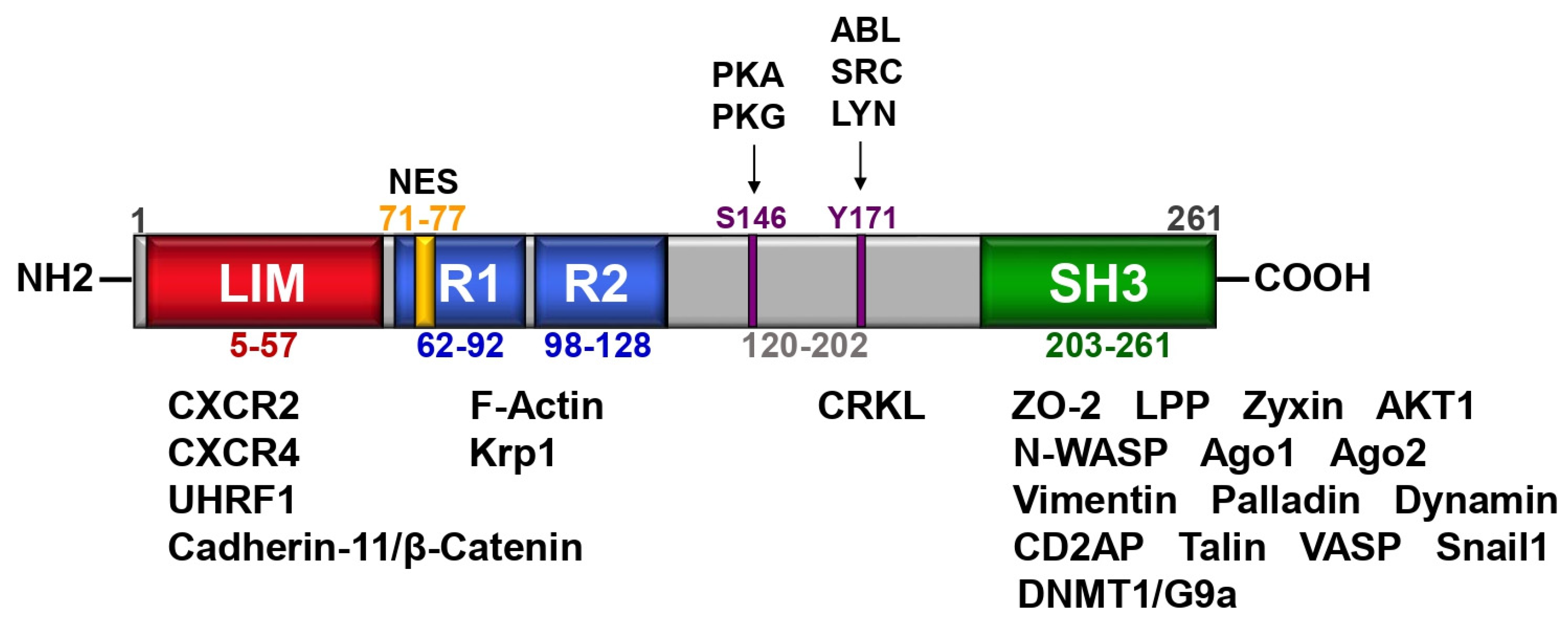
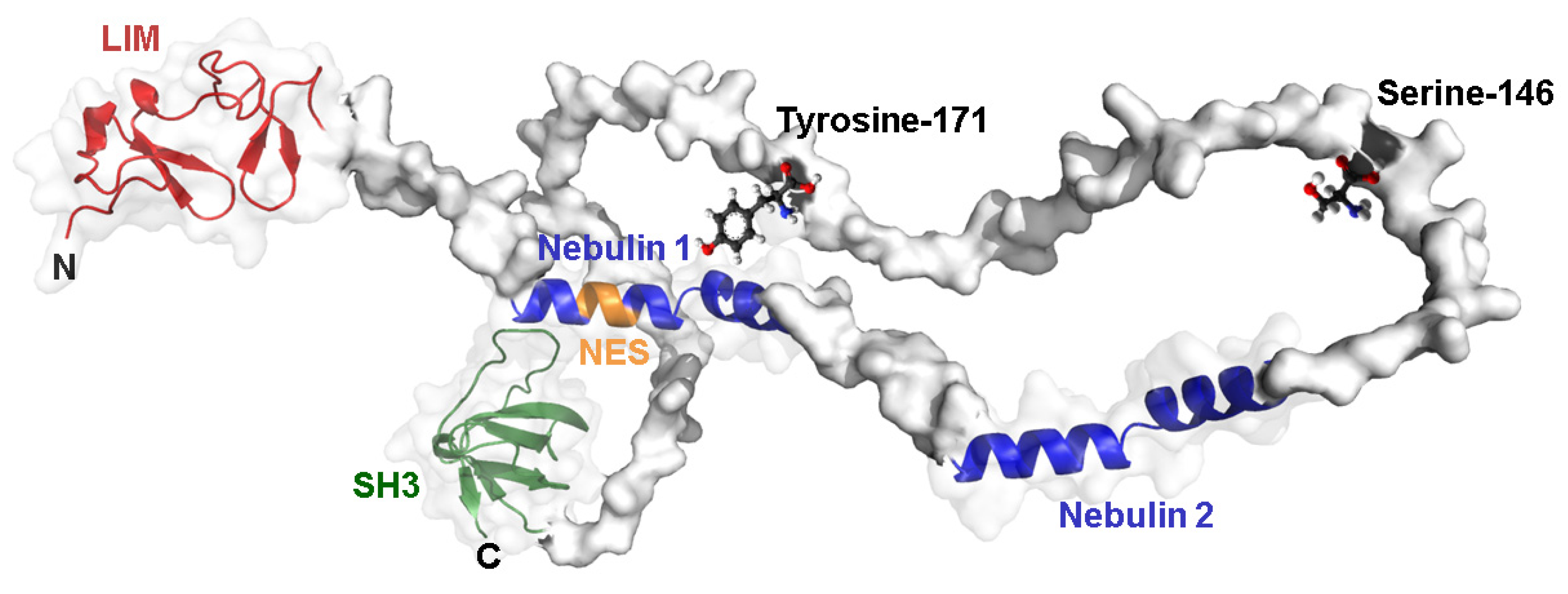
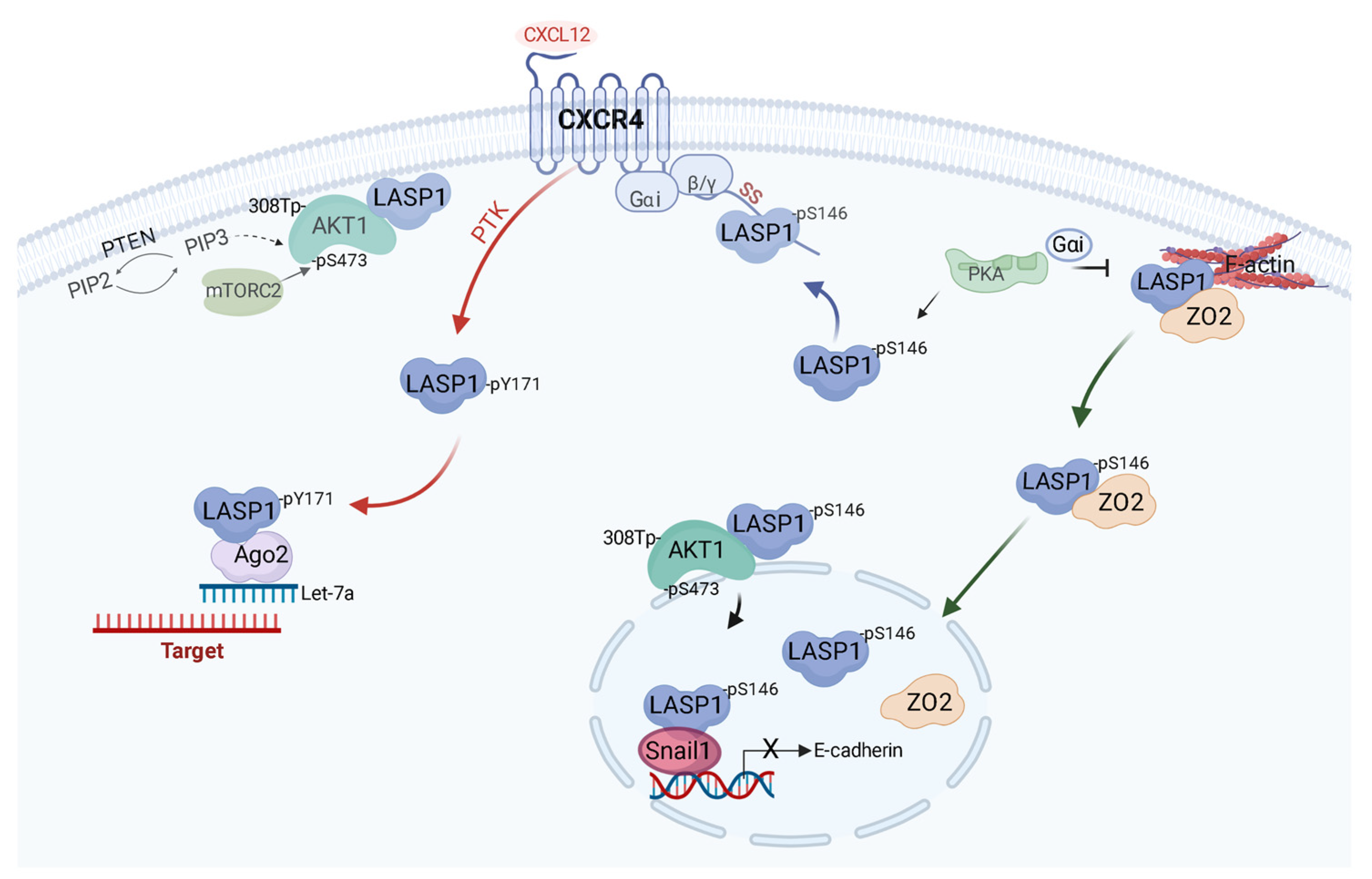
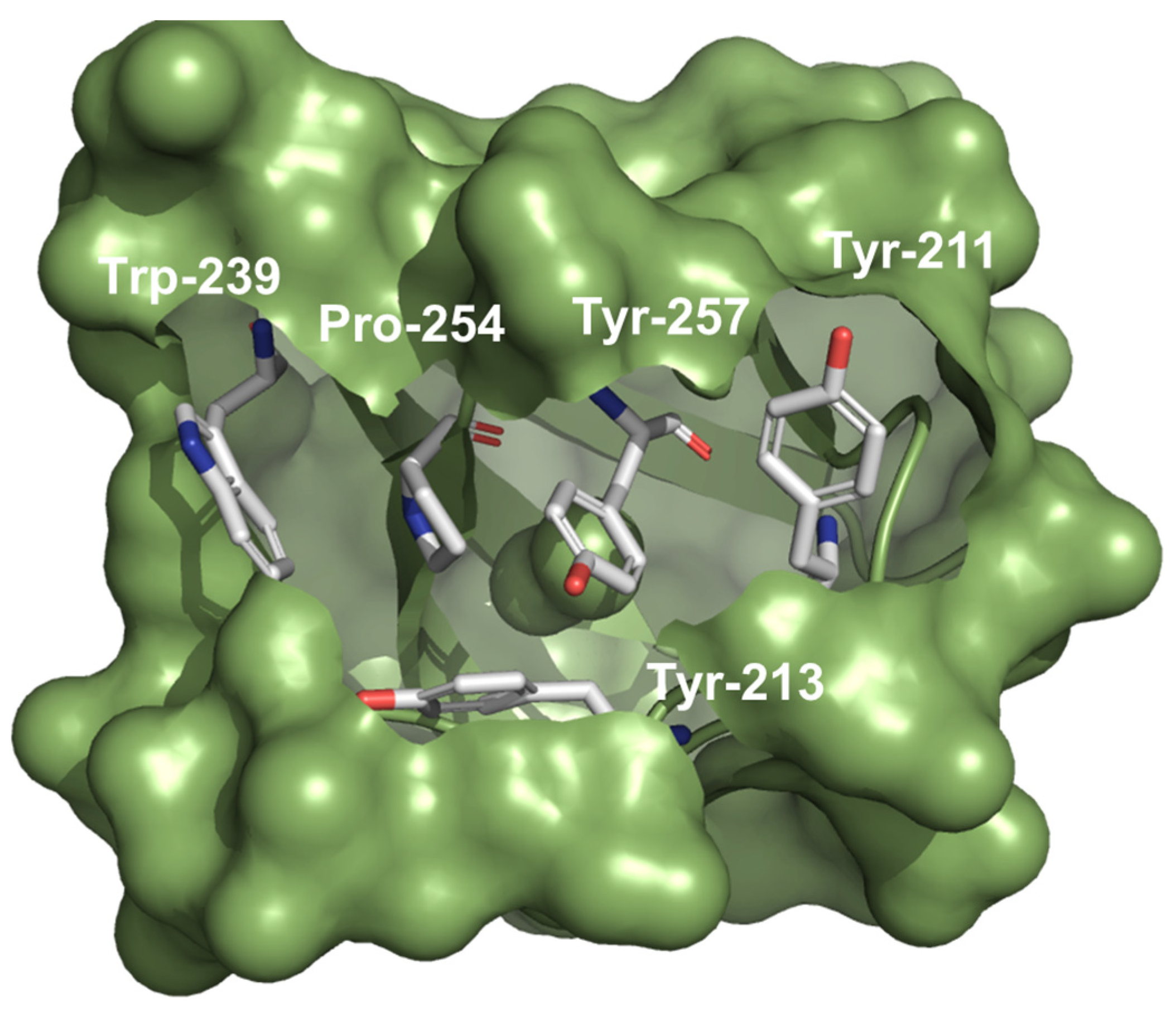
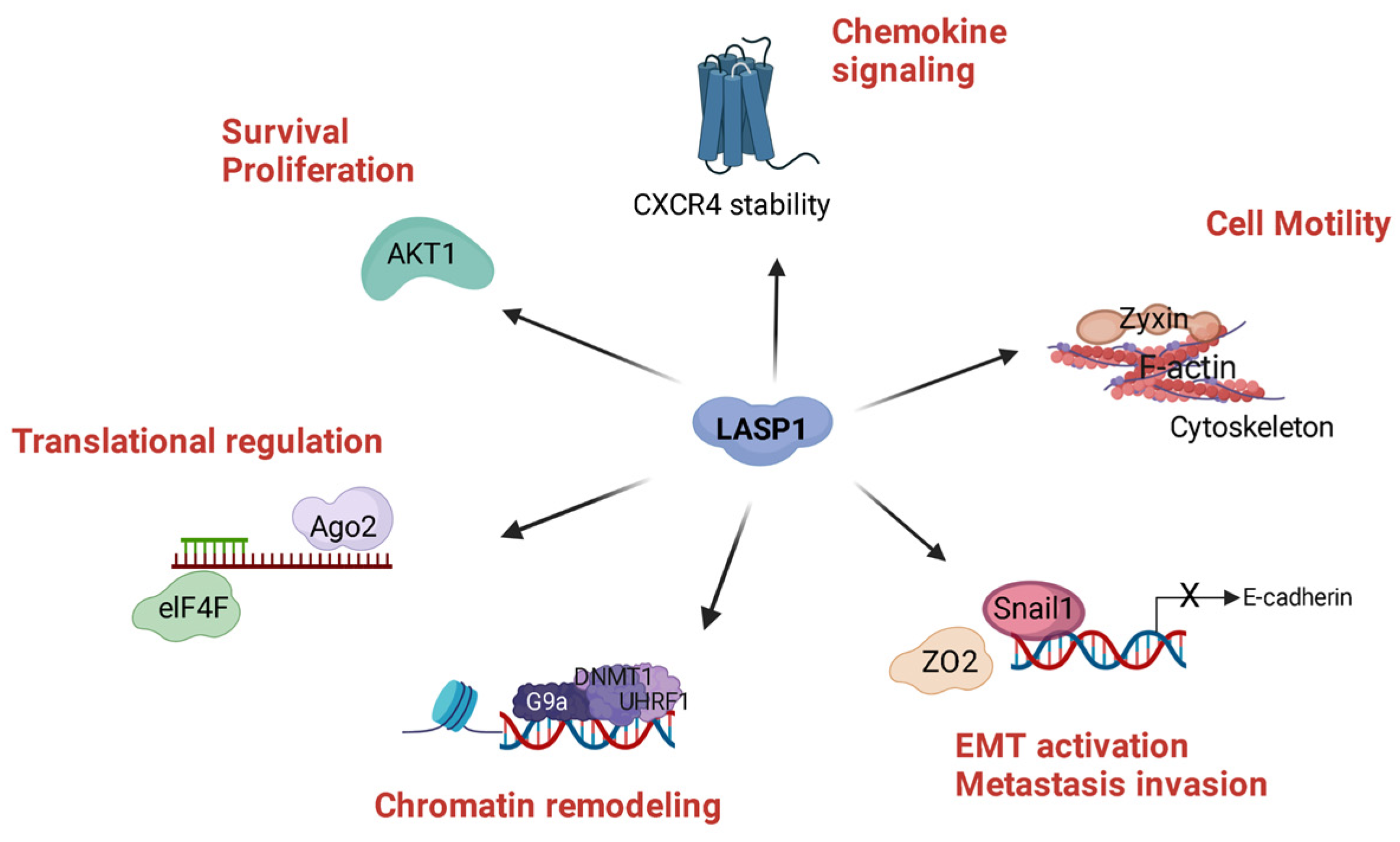
Publisher’s Note: MDPI stays neutral with regard to jurisdictional claims in published maps and institutional affiliations. |
© 2022 by the authors. Licensee MDPI, Basel, Switzerland. This article is an open access article distributed under the terms and conditions of the Creative Commons Attribution (CC BY) license (https://creativecommons.org/licenses/by/4.0/).
Share and Cite
Butt, E.; Howard, C.M.; Raman, D. LASP1 in Cellular Signaling and Gene Expression: More than Just a Cytoskeletal Regulator. Cells 2022, 11, 3817. https://doi.org/10.3390/cells11233817
Butt E, Howard CM, Raman D. LASP1 in Cellular Signaling and Gene Expression: More than Just a Cytoskeletal Regulator. Cells. 2022; 11(23):3817. https://doi.org/10.3390/cells11233817
Chicago/Turabian StyleButt, Elke, Cory M. Howard, and Dayanidhi Raman. 2022. "LASP1 in Cellular Signaling and Gene Expression: More than Just a Cytoskeletal Regulator" Cells 11, no. 23: 3817. https://doi.org/10.3390/cells11233817
APA StyleButt, E., Howard, C. M., & Raman, D. (2022). LASP1 in Cellular Signaling and Gene Expression: More than Just a Cytoskeletal Regulator. Cells, 11(23), 3817. https://doi.org/10.3390/cells11233817





